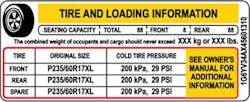A while back, legislation known as the FAST [Fixing America’s Surface Transportation] ACT was signed into law. Buried in the litany of provisions covered by this Transportation Bill, which range from point of sale tire registration to the funding of infrastructure improvement, was a few paragraphs regarding Tire Pressure Monitoring Systems [TPMS]. While enforcement of these provisions is a ways off, and no clear indication of how they will be applied, we at Bartec are happy with the context and direction! In our opinion, the things that are a cornerstone of our message, like investing in the proper tools and training to better serve their customers, have been confirmed, at least in part, by the text of this new law!
“(1) updates the standards pertaining to tire pressure monitoring systems to ensure that a tire pressure monitoring system that is installed in a new motor vehicle after the effective date of such updated standards cannot be overridden, reset, or recalibrated in such a way that the system will no longer detect when the inflation pressure in one or more of the vehicle’s tires has fallen to or below a significantly underinflated pressure level;”
We’ll leave the law’s ultimate interpretation and application to the legal experts. However, it is Bartec’s that view the wording, at a minimum, seems to suggest that we are on the right track with our strategy and tool features and functions. Specifically speaking we think the verbiage means:
1. The systems cannot be overridden, and
2. TPMS service must always be completed in such a way as to NOT cause the system to no longer detect when the inflation pressure in one or more of the vehicle’s tires has fallen to or below a significantly underinflated pressure level.
I think we can all agree, purposely overriding vehicle safety systems is NEVER a good idea. How then, might a service provider unknowingly override a TPMS? According to the definition, anything that modifies or suspends the ordinary function of the TPMS would accomplish this. One way this could happen is plus sizing wheel and tire fitments. Let’s say a customer wishes to plus size their vehicle to the extent that impacts recommended inflation pressure [RIM], the vehicle’s TPMS must be recalibrated to that new RIM. WHAT DO YOU DO?
If you first consider that the original rule guiding TPMS performance states that the driver must be given a warning when tire pressure is 25 percent or more below the placard pressure for one to four tires, you might see where this is heading. If this customer’s new wheel and tire package require that the RIM be higher than what the vehicle is currently placarded for, therein lies the problem. If your customer’s new wheel and tire package requires a recommended inflation pressure of 50 PSI and the vehicle’s TPMS is currently set at 35 PSI, the new tires would have to be HALF FLAT before the TPMS Low-Pressure Indicator illuminated. This is clearly not safe and certainly not compliant with the rule. Some might question whether or not this makes the TPMS inoperative. Bartec suggests not even going there.
Change the Placard! Can you do it? Well, that depends on the TPMS Tool that you have. But if the question is can you do it LEGALLY, the answer is yes. Provided you follow these best practices:
1. Never lessen the vehicle's load carrying capacity
2. Always apply a supplemental placard label next to the factory label
3. Educate and inform your customer of how TPMS works and why the change to the system is needed
4. Always provide your customer with TPMS inspection report that covers the original placard value, the new settings, and the sensor ID’s by position.
If you have any questions regarding placard changing, how it’s done, or need some tips and tricks, call the Bartec USA’s Technical Support Line at [866] 407-8767.




